 Share prices are determined by demand and supply. The same applies to stock market indices, such as the FTSE 100 and FTSE 250 in the UK and the Dow Jones Industrial Average and the S&P 500 in the USA. After all, the indices are the weighted average prices of the shares included in the index. Generally, when economies are performing well, or are expected to do so, share prices will rise. They are likely to fall in a recession or if a recession is anticipated. A main reason for this is that the dividends paid on shares will reflect the profitability of firms, which tends to rise in times of a buoyant economy.
Share prices are determined by demand and supply. The same applies to stock market indices, such as the FTSE 100 and FTSE 250 in the UK and the Dow Jones Industrial Average and the S&P 500 in the USA. After all, the indices are the weighted average prices of the shares included in the index. Generally, when economies are performing well, or are expected to do so, share prices will rise. They are likely to fall in a recession or if a recession is anticipated. A main reason for this is that the dividends paid on shares will reflect the profitability of firms, which tends to rise in times of a buoyant economy.
When it first became clear that Covid-19 would become a pandemic and as countries began locking down, so stock markets plummeted. People anticipated that many businesses would fail and that the likely recession would cause profits of many other surviving firms to decline rapidly. People sold shares.
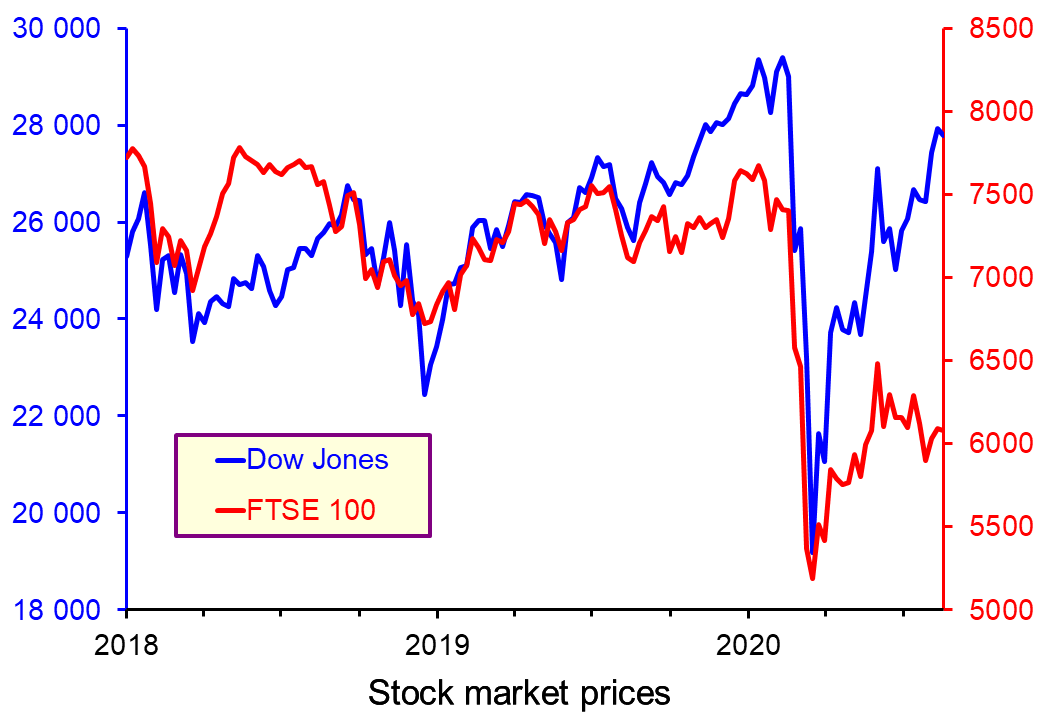 The first chart shows how the FTSE 100 fell from 7466 in early February 2020 to 5190 in late March, a fall of 30.5%. The Dow Jones fell by 34% over the same period. In both cases the fall was driven not only by the decline in the respective economy over the period, but by speculation that further declines were to come (click here for a PowerPoint of the chart).
The first chart shows how the FTSE 100 fell from 7466 in early February 2020 to 5190 in late March, a fall of 30.5%. The Dow Jones fell by 34% over the same period. In both cases the fall was driven not only by the decline in the respective economy over the period, but by speculation that further declines were to come (click here for a PowerPoint of the chart).
But then stock markets started rising again, especially the Dow Jones, despite the fact that the recessions in the UK, the USA and other countries were gathering pace. In the second quarter of 2020, the Dow Jones rose by 23% and yet the US economy declined by 33% – the biggest quarterly decline on record. How could this be explained by supply and demand?
Quantitative easing
In order to boost aggregate demand and reduce the size of the recession, central banks around the world engaged in large-scale quantitative easing. 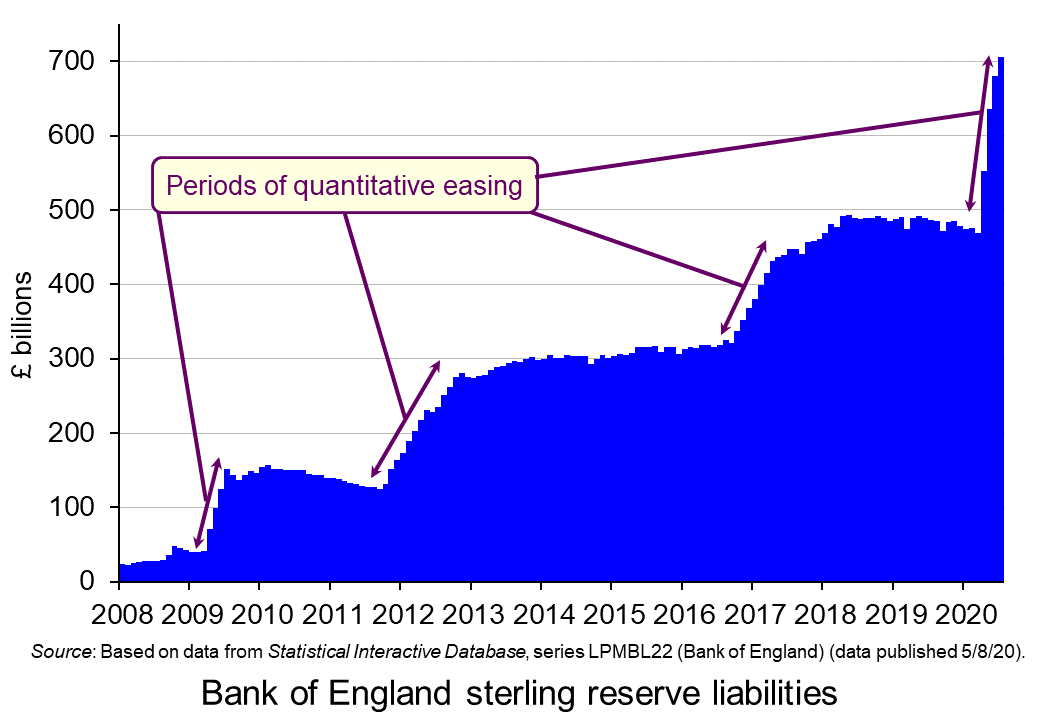 This involves central banks buying government bonds and possibly corporate bonds too with newly created money. The extra money is then used to purchase other assets, such as stocks and shares and property, or physical capital or goods and services. The second chart shows that quantitative easing by the Bank of England increased the Bank’s asset holding from April to July 2020 by 50%, from £469bn to £705bn (click here for a PowerPoint of the chart).
This involves central banks buying government bonds and possibly corporate bonds too with newly created money. The extra money is then used to purchase other assets, such as stocks and shares and property, or physical capital or goods and services. The second chart shows that quantitative easing by the Bank of England increased the Bank’s asset holding from April to July 2020 by 50%, from £469bn to £705bn (click here for a PowerPoint of the chart).
But given the general pessimism about the state of the global economy, employment and personal finances, there was little feed-through into consumption and investment. Instead, most of the extra money was used to buy assets. This gave a huge boost to stock markets. Stock market movements were thus out of line with movements in GDP.
Confidence
Stock market prices do not just reflect the current economic and financial situation, but also what people anticipate the situation to be in the future. 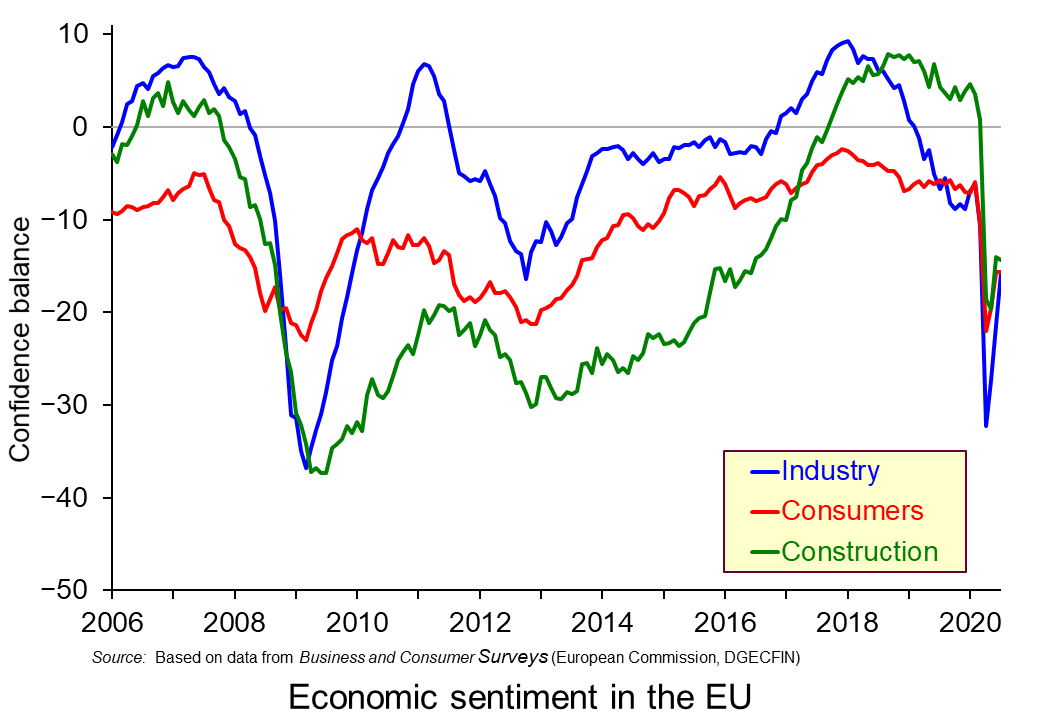 As infection and death rates from Covid-19 waned around Europe and in many other countries, so consumer and business confidence rose. This is illustrated in the third chart, which shows industrial, consumer and construction confidence indicators in the EU. As you can see, after falling sharply as the pandemic took hold in early 2020 and countries were locked down, confidence then rose (click here for a PowerPoint of the chart).
As infection and death rates from Covid-19 waned around Europe and in many other countries, so consumer and business confidence rose. This is illustrated in the third chart, which shows industrial, consumer and construction confidence indicators in the EU. As you can see, after falling sharply as the pandemic took hold in early 2020 and countries were locked down, confidence then rose (click here for a PowerPoint of the chart).
But, as infection rates have risen somewhat in many countries and continue to soar in the USA, Brazil, India and some other countries, this confidence may well start to fall again and this could impact on stock markets.
Speculation
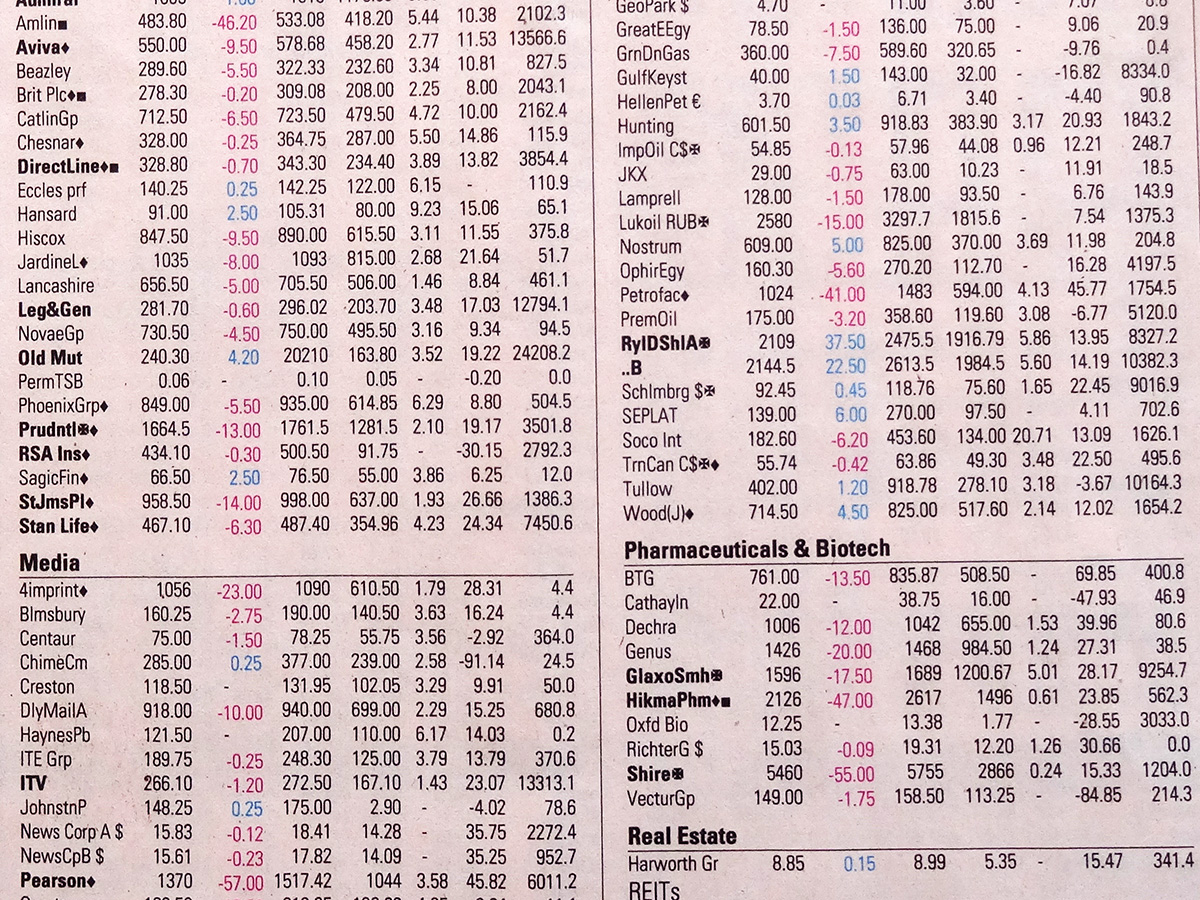 A final, but related, cause of recent stock market movements is speculation. If people see share prices falling and believe that they are likely to fall further, then they will sell shares and hold cash or safer assets instead. This will amplify the fall and encourage further speculation. If, however, they see share prices rising and believe that they will continue to do so, they are likely to want to buy shares, hoping to make a gain by buying them relatively cheaply. This will amplify the rise and, again, encourage further speculation.
A final, but related, cause of recent stock market movements is speculation. If people see share prices falling and believe that they are likely to fall further, then they will sell shares and hold cash or safer assets instead. This will amplify the fall and encourage further speculation. If, however, they see share prices rising and believe that they will continue to do so, they are likely to want to buy shares, hoping to make a gain by buying them relatively cheaply. This will amplify the rise and, again, encourage further speculation.
If there is a second wave of the pandemic, then stock markets could well fall again, as they could if speculators think that share prices have overshot the levels that reflect the economic and financial situation. But then there may be even further quantitative easing.
There are many uncertainties, both with the pandemic and with governments’ policy responses. These make forecasting stock market movements very difficult. Large gains or large losses could await people speculating on what will happen to share prices.
Articles
Questions
- Illustrate the recent movements of stock markets using demand and supply diagrams. Explain your diagrams.
- What determines the price elasticity of demand for shares?
- Distinguish between stabilising and destabilising speculation. How are the concepts relevant to the recent history of stock market movements?
- Explain how quantitative easing works to increase (a) asset prices; (b) aggregate demand.
- What is the difference between quantitative easing as currently conducted by central banks and ‘helicopter money‘?
- Give some examples of companies whose share prices have risen strongly since March 2020. Explain why these particular shares have done so well.
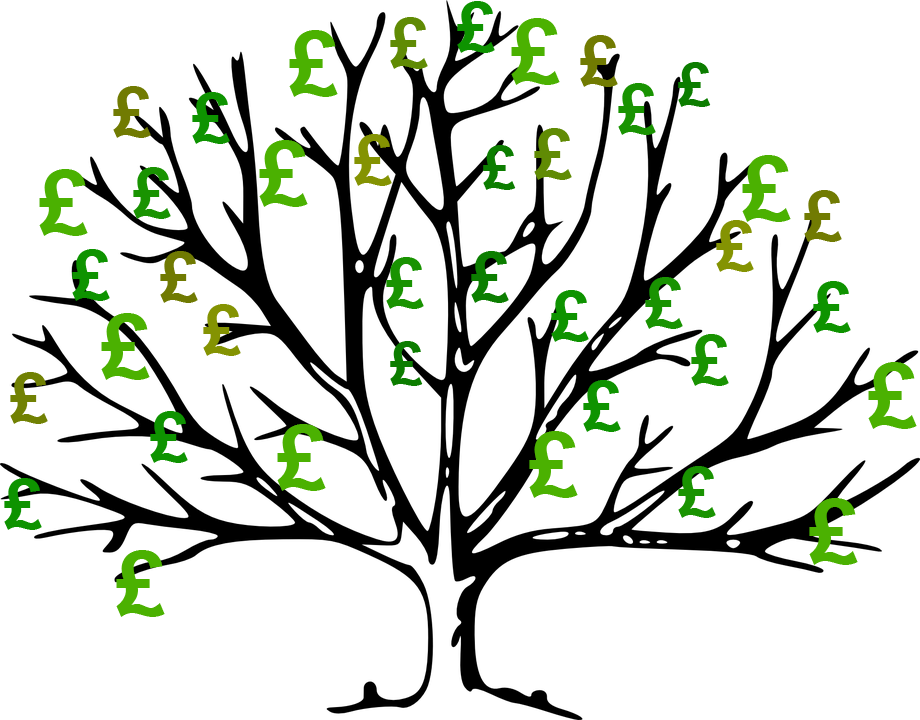 Is there a ‘magic money tree’? Is it desirable for central banks to create money to finance government deficits?
Is there a ‘magic money tree’? Is it desirable for central banks to create money to finance government deficits?
The standard thinking of conservative governments around the world is that creating money to finance deficits will be inflationary. Rather, governments should attempt to reduce deficits. This will reduce the problem of government expenditure crowding out private expenditure and reduce the burden placed on future generations of having to finance higher government debt.
If deficits rise because of government response to an emergency, such as supporting people and businesses during the Covid-19 pandemic, then, as soon as the problem begins to wane, governments should attempt to reduce the higher deficits by raising taxes or cutting government expenditure. This was the approach of many governments, including the Coalition and Conservative governments in the UK from 2010, as econommies began to recover from the 2007/8 financial crisis.
 ‘Modern Monetary Theory‘ challenges these arguments. Advocates of the theory support the use of higher deficits financed by monetary expansion if the money is spent on things that increase potential output as well as actual output. Examples include spending on R&D, education, infrastructure, health and housing.
‘Modern Monetary Theory‘ challenges these arguments. Advocates of the theory support the use of higher deficits financed by monetary expansion if the money is spent on things that increase potential output as well as actual output. Examples include spending on R&D, education, infrastructure, health and housing.
Modern monetary theorists still accept that excess demand will lead to inflation. Governments should therefore avoid excessive deficits and central banks should avoid creating excessive amounts of money. But, they argue that inflation caused by excess demand has not been a problem for many years in most countries. Instead, we have a problem of too little investment and too little spending generally. There is plenty of scope, they maintain, for expanding demand. This, if carefully directed, can lead to productivity growth and an expansion of aggregate supply to match the rise in aggregate demand.
Government deficits, they argue, are not intrinsically bad. Government debt is someone else’s assets, whether in the form of government bonds, savings certificates, Treasury bills or other instruments. Provided the debt can be serviced at low interest rates, there is no problem for the government and the spending it generates can be managed to allow economies to function at near full capacity.
The following videos and articles look at modern monetary theory and assess its relevance. Not surprisingly, they differ in their support of the theory!
Videos
Articles
- Modern monetary theory: the rise of economists who say huge government debt is not a problem
The Conversation, John Whittaker (7/7/20)
- Modern Monetary Theory: How MMT is challenging the economic establishment
ABC News, Gareth Hutchens (20/7/20)
- What is Modern Monetary Theory and is it THE answer?
Sydney Morning Herald, Jessica Irvine (2/7/20)
- MMT: what is modern monetary theory and will it work?
MoneyWeek, Stuart Watkins (14/7/20)
- MMT: the magic money tree bears fruit
MoneyWeek, Stuart Watkins (17/7/20)
- Modern Monetary Theory is no Magic Money Tree
Adam Smith Institute, Matt Kilcoyne (20/5/20)
- “Modern Monetary Theory” Goes Mainstream
Forbes, Nathan Lewis (10/7/20)
- How Boris Johnson’s Conservatives have become Magic Money Tree huggers
The Scotsman, Bill Jamieson (16/7/20)
- Ignore the impacts of debt-fuelled stimulus at your peril
Livewire, David Rosenbloom (14/7/20)
- Modern Monetary Theory, explained
Vox.com, Dylan Matthews (16/4/19)
Questions
- Compare traditional Keynesian economics and modern monetary theory.
- Using the equation of exchange, MV = PY, what would a modern monetary theorist say about the effect of an expansion of M on the other variables?
- What is the role of fiscal policy in modern monetary theory?
- What evidence might suggest that money supply has been unduly restricted?
- When, according to modern monetary theory, is a rising government deficit (a) not a problem; (b) a problem?
- Is there any truth in the saying, ‘There’s no such thing as a magic money tree’?
- Provide a critique of modern monetary theory.
 At its meeting on 6 May, the Bank of England’s Monetary Policy Committee decided to keep Bank Rate at 0.1%. Due to the significant impact of COVID-19 and the measures put in place to try to contain the virus, the MPC voted unanimously to keep Bank Rate the same.
At its meeting on 6 May, the Bank of England’s Monetary Policy Committee decided to keep Bank Rate at 0.1%. Due to the significant impact of COVID-19 and the measures put in place to try to contain the virus, the MPC voted unanimously to keep Bank Rate the same.
However, it decided not to launch a new stimulus programme, with the committee voting by a majority of 7-2 for the Bank to continue with the current programme of quantitative easing. This involves the purchase of £200 billion of government and sterling non-financial investment-grade corporate bonds, bringing the total stock of bonds held by the Bank to £645 billion.
The Bank forecast that the crisis will put the economy into its deepest recession in 300 years, with output plunging 30 per cent in the first half of the year.
Monetary policy and MPC
Monetary policy is the tool used by the UK’s central bank to influence how much money is in the economy and how much it costs to borrow. The Bank of England’s main monetary policy tools include setting the Bank Rate and quantitative easing (QE). Bank Rate is the interest rate charged to banks when they borrow money from the BoE. QE is the process of creating money digitally to buy corporate and government bonds.
The BoE’s Monetary Policy Committee (MPC) sets monetary policy to meet the 2% inflation target. Maintaining a low and stable inflation rate is good for the economy and it is the main monetary policy aim. However, the Bank also has to balance this target with the government’s other economic aims of sustaining growth and employment in the economy.
Actions taken by the MPC
It is challenging to respond to severe economic and financial disruption, with the UK economy looking unusually uncertain. Activity has fallen sharply since the beginning of the year and unemployment has risen markedly. The current rate of inflation, measured by the Consumer Price Index (CPI), declined to 1.5% in March and is likely to fall below 1% in the next few months. Household consumption has fallen by around 30% as consumer confidence has declined. Companies’ sales are expected to be around 45% lower than normal and business investment 50% lower.
In the current circumstances, and consistent with the MPC’s remit, monetary policy is aimed at supporting businesses and households through the crisis and limiting any lasting damage to the economy. The Bank has used both main monetary tools to fulfil its mandate and attempt to boost the economy amid the current lockdown. The Bank Rate was reduced to 0.1% in March, the lowest level in the Bank’s 325-year history and the current programme of QE was introduced in March.
What is next?
This extraordinary time has seen the outlook for the all global economies become uncertain.  The long-term outcome will depend critically on the evolution of the pandemic, and how governments, households and businesses respond to it. The Bank of England has stated that businesses and households will need to borrow to get through this period and is encouraging banks and building societies to increase their lending. Britain’s banks are warned that if they try to stem losses by restricting lending, they will make the situation worse. The Bank believes that the banks are strong enough to keep lending, which will support the economy and limit losses to themselves.
The long-term outcome will depend critically on the evolution of the pandemic, and how governments, households and businesses respond to it. The Bank of England has stated that businesses and households will need to borrow to get through this period and is encouraging banks and building societies to increase their lending. Britain’s banks are warned that if they try to stem losses by restricting lending, they will make the situation worse. The Bank believes that the banks are strong enough to keep lending, which will support the economy and limit losses to themselves.
In the short term, a bleak picture of the UK economy is suggested, with a halving in business investment, a near halving in business sales, a sharp rise in unemployment and households cutting their spending by a third. Despite its forecast that GDP could shrink by 14% for 2020, the Bank of England is forecasting a ‘V’ shaped recovery. In this scenario, the recovery in economic activity, once measures are softened, is predicted to be relatively rapid and inflation rises to around the 2 per cent target. However, this would be after a dip to 0.5% in 2021, before returning to the 2 per cent target the following year.
However, there are some suggestions that the Bank’s forecast for the long-term recovery is too optimistic. Yael Selfin, chief economist at KPMG UK, fears the UK economy could shrink even more sharply than the Bank of England has forecast.
Despite the stark numbers issued by the Bank of England today, additional pressure on the economy is likely. Some social distancing measures are likely to remain in place until we have a vaccine or an effective treatment for the virus, with people also remaining reluctant to socialise and spend. That means recovery is unlikely to start in earnest before sometime next year.
 There are also additional factors that could dampen future productivity, such as the impact on supply chains, with ‘just-in-time’ operations potentially being a thing of the past.
There are also additional factors that could dampen future productivity, such as the impact on supply chains, with ‘just-in-time’ operations potentially being a thing of the past.
There is also the ongoing issue of Brexit. This is a significant downside risk as the probability of a smooth transition to a comprehensive free-trade agreement with the EU in January is relatively small. This will only increase uncertainty for businesses along with the prospect of increased trade frictions next year.
Conclusion
The predictions from the Bank of England are based on many assumptions, one of which is that the economy will only be gradually released from lockdown. Its numbers contain the expectations that consumer and worker behaviour will change significantly, and continue for some time, with forms of voluntary social distancing. On the other hand, Mr Bailey expects the recovery to be much faster than seen with the financial crisis a decade ago. However, again this is based on the assumption that measures put in place from the public health side prevent a second wave of the virus.
It also assumes that the supply-side effects on the economy will be limited in the long run. Many economists disagree, arguing that the ‘scarring effects’ of the lockdown may be substantial. These include lower rates of investment, innovation and start ups and the deskilling effects on labour. They also include the businesses that have gone bankrupt and the dampening effect on consumer and business confidence. Finally, with a large increase in lending to tide firms over the crisis, many will face problems of debt, which will dampen investment.
The Bank of England does recognise these possible scarring effects. Specifically, it warns of the danger of a rise in equilibrium unemployment:
It is possible that the rise in unemployment could prove more persistent than embodied in the scenario, for example if companies are reluctant to hire until they are sure about the robustness of the recovery in demand. It is also possible that any rise in unemployment could lead to an increase in the long‑term equilibrium rate of unemployment. That might happen if the skills of the unemployed do not increase to the same extent as they would if they were working, for example, or even erode over time.
What is certain, however, is that the long-term picture will only become clearer when we start to come out of the crisis. Bailey implied that the Bank is taking a wait-and-see approach for now, waiting on the UK government to shed some light about easing of lockdown measures before taking any further action with regards to QE. The MPC will continue to monitor the situation closely and, consistent with its remit, stands ready to take further action as necessary to support the economy and ensure a sustained return of inflation to the 2% target. Paul Dales, chief UK economist at Capital Economics, suggested that the central bank is signalling that ‘more QE is coming, if not in June, then in August’.
Articles
Bank of England publication
Questions
- How could the BoE use monetary policy to boost the economy?
- Explain how changes in interest rates affect aggregate demand.
- Define and explain quantitative easing (QE).
- How might QE help to stimulate economic growth?
- How is the pursuit of QE likely to affect the price of government bonds? Explain.
- Evaluate the extent to which monetary policy is able to stimulate the economy and achieve price stability.
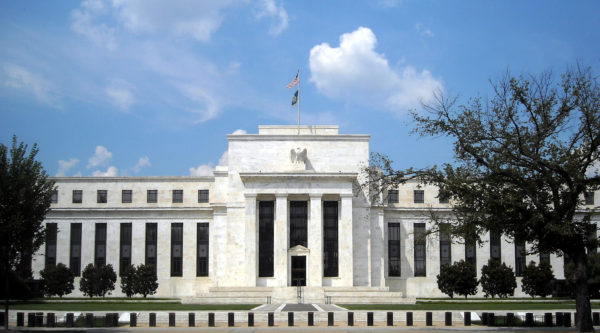 The monetary policy mandates of central banks have an impact on all our lives. While the terminology might not be familiar to many outside economics, their impact is, however, undeniably important. This is because they set out the objectives for the operation of monetary policy. Adjustments to interest rates or the growth of the money supply, which affect us all, reflect the mandate given to the central bank.
The monetary policy mandates of central banks have an impact on all our lives. While the terminology might not be familiar to many outside economics, their impact is, however, undeniably important. This is because they set out the objectives for the operation of monetary policy. Adjustments to interest rates or the growth of the money supply, which affect us all, reflect the mandate given to the central bank.
Since 1977 the mandate given to the Federal Reserve (the US central bank) by Congress has been to promote effectively the goals of maximum employment, stable prices, and moderate long-term interest rates. This mandate has become known as the dual mandate because it emphasises both employment and stable prices. Since 2012, the Federal Reserve’s Open Market Committee has issued an annual statemenent of its long-run goals. The latest was published in January 2019. Since this time, the Federal Reserve has explicitly set the ‘longer-run goal for inflation’ at 2 per cent. It has also emphasised that it would be ‘concerned’ if the inflation rate was persistently above or below this level.
In November 2018 the Federal Reserve began a review of its monetary policy strategy, its tools and how it communicates monetary policy. The review is being conducted within the guidelines that its statutory mandate gives and as well as the longer-term inflation goal of 2 per cent. However, one of the issues being addressed by the review is how the operation of monetary policy can avoid the rate of inflation frequently undershooting 2 per cent, as it has done since the financial crisis of the late 2000s and the introduction of the 2 per cent inflation rate target.
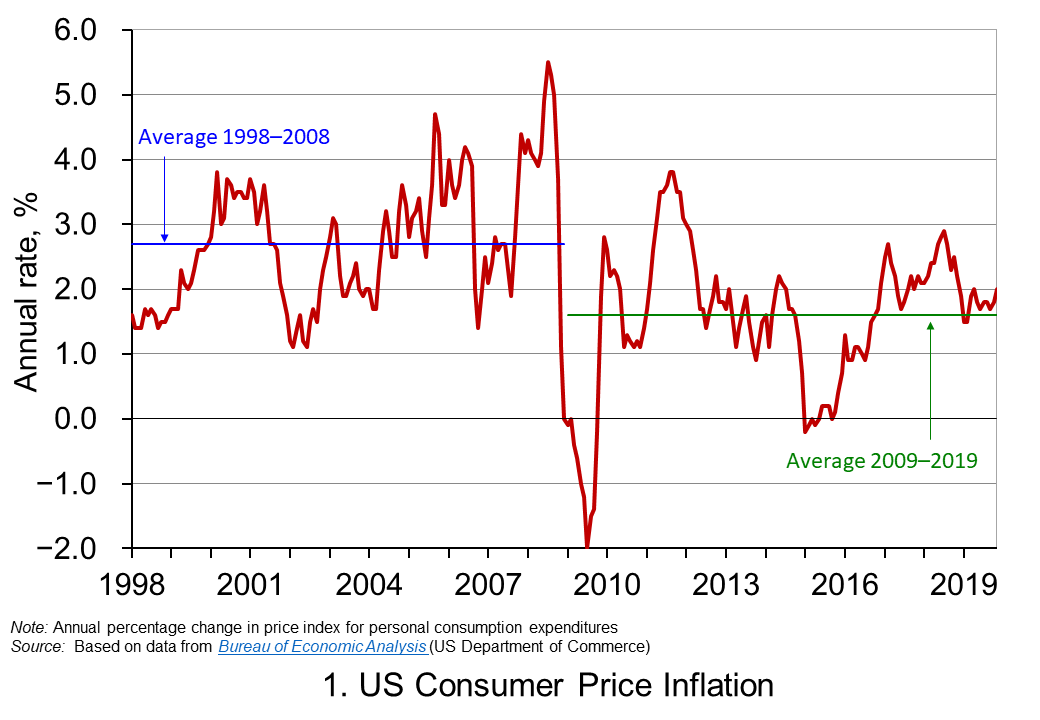 Chart 1 shows the annual rate of consumer price inflation in the US since 1998. It helps to illustrate the concern that low inflation rates can become entrenched. The chart shows that, while the average inflation rate from 1998 to 2008 was 2.7 per cent, from 2009 the average has been only 1.6 per cent. Interestingly, the average since 2012, when the explicit 2 per cent goal was introduced, to the present day is also 1.6 per cent. (Click here to download the PowerPoint chart.)
Chart 1 shows the annual rate of consumer price inflation in the US since 1998. It helps to illustrate the concern that low inflation rates can become entrenched. The chart shows that, while the average inflation rate from 1998 to 2008 was 2.7 per cent, from 2009 the average has been only 1.6 per cent. Interestingly, the average since 2012, when the explicit 2 per cent goal was introduced, to the present day is also 1.6 per cent. (Click here to download the PowerPoint chart.)
The concern going forward is that the natural or neutral rate of interest, which is the policy rate at which the rate of inflation is close to its target level and the level of output is close to its potential level, is now lower than in the recent past. Hence, when the next downturn occurs there is likely to be less room for cutting interest rates. Hence, the review is looking, in essence, to future-proof the conduct of monetary policy.
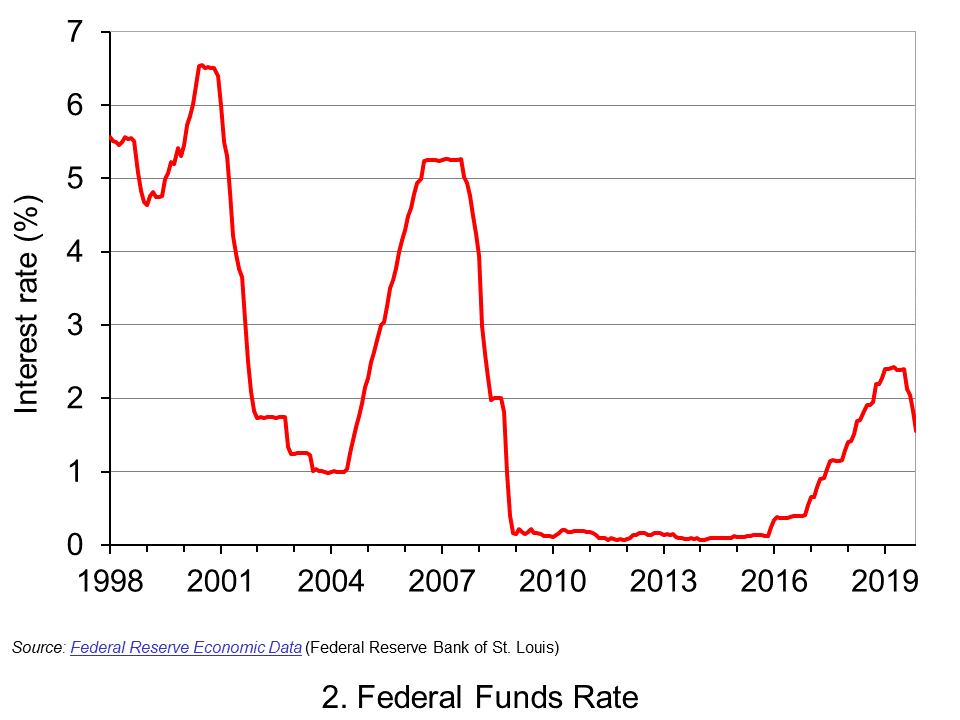 Chart 2 shows the Federal Fund rate since 1998. This is the rate at which commercial banks lend to each other the reserve balances they hold at the Federal Reserve in order to meet their reserve requirements. The Federal Reserve can affect this rate through buying or selling government securities. If it wants to drive up rates, it can sell holdings of government securities and reduce the money supply. If it wants to drive rates down, it can buy government securities and increase the money supply. The effects then ripple through to other interest rates and, in turn, aggregate demand and inflation. (Click here to download a copy of the PowerPoint chart.)
Chart 2 shows the Federal Fund rate since 1998. This is the rate at which commercial banks lend to each other the reserve balances they hold at the Federal Reserve in order to meet their reserve requirements. The Federal Reserve can affect this rate through buying or selling government securities. If it wants to drive up rates, it can sell holdings of government securities and reduce the money supply. If it wants to drive rates down, it can buy government securities and increase the money supply. The effects then ripple through to other interest rates and, in turn, aggregate demand and inflation. (Click here to download a copy of the PowerPoint chart.)
We can see from Chart 2 the dramatic cuts made by the Federal Reserve to interest rates as the financial crisis unfolded. The subsequent ‘normalisation’ of the Federal Funds rate in the 2010s saw the Federal Funds Rate rise to no higher than between 2.25 and 2.5 per cent. Then in 2019 the Federal Reserve began to cut rates again. This was despite historically-low unemployment rates. In November 2019 the unemployment rate fell to 3.5 per cent, its lowest since 1969. This has helped fuel the argument among some economists and financiers, which we saw earlier, that that the natural (or neutral) interest rate is now lower.
If the natural rate is lower, then this raises concerns about the effectiveness of monetary policy in future economic downturns. In this context, the review is considering ways in which the operation of monetary policy would be able to prevent the rate of inflation consistently undershooting its target. This includes a discussion of how the Fed can prevent inflationary expectations becoming anchored below 2 per cent. This is important because, should they do so, they help to anchor the actual rate of inflation below 2 per cent. One possibility being considered is an inflation make-up strategy. In other words, a period of below-target inflation rates would need to be matched by a period where inflation rates could exceed the 2 per cent target in order that the long-term average of 2 per cent is met.
An inflation make-up policy would work like forward guidance in that people and markets would know know that short-term interest rates would be kept lower for longer. This would then help to force longer-term interest rates lower as well as providing people and businesses with greater certainty that interest rates will be lower for longer. This could help to encourage spending, raise economic growth and prevent inflation from overshooting its target for any extensive period of time.
An inflation make-up strategy would, in part, help to cement the idea that the inflation target is effectively symmetrical and that 2 per cent is not an upper limit for the inflation rate. But, it would do more than that: it would allow the Fed to deliberately exceed the 2 per cent target.
An inflation make-up strategy does raise issues. For example, how would the Fed determine the magnitude of any inflation make-up and for how long would a looser monetary stance be allowed to operate? In other words, would an inflation make-up strategy be determined by a specific rule or formula? Or, would the principle be applied flexibly? Finally, could a simpler alternative be to raise the target rate itself, given the tendency to undershoot the 2 per cent target rate? If so, what should that the rate be?
We should know by the end of 2020 whether the Federal Reserve will adopt, when necessary, an inflation make-up monetary policy.
Articles
Questions
- What do you understand by the monetary policy mandate of a central bank?
- Explain the ways in which the monetary policy mandate of the central bank affects our everyday lives.
- Why are inflation-rate expectations important in determining actual inflation rates?
- Why is the Federal Reserve concerned about its ability to use monetary policy effectively during future economic downturns?
- Discuss the economic arguments for and against central banks operating strict inflation-rate targets.
- Does the case for adopting an inflation make-up monetary policy mandate show that the argument for inflation-rate targeting has been lost?
- What do you understand by the idea of a natural or neutral policy interest rate? Would the actual rate be expected to be above or below this if the rate of inflation was below its target level?
 The Institute of Fiscal Studies (IFS) has just published its annual ‘Green Budget‘. This is, in effect, a pre-Budget report (or a substitute for a government ‘Green Paper’) and is published ahead of the government’s actual Budget.
The Institute of Fiscal Studies (IFS) has just published its annual ‘Green Budget‘. This is, in effect, a pre-Budget report (or a substitute for a government ‘Green Paper’) and is published ahead of the government’s actual Budget.
The Green Budget examines the state of the UK economy, likely economic developments and the implications for macroeconomic policy. This latest Green Budget is written in the context of Brexit and the growing likelihood of a hard Brexit (i.e. a no-deal Brexit). It argues that the outlook for the public finances has deteriorated substantially and that the economy is facing recession if the UK leaves the EU without a deal.
It predicts that:
Government borrowing is set to be over £50 billion next year (2.3% of national income), more than double what the OBR forecast in March. This results mainly from a combination of spending increases, a (welcome) change in the accounting treatment of student loans, a correction to corporation tax revenues and a weakening economy. Borrowing of this level would breach the 2% of national income ceiling imposed by the government’s own fiscal mandate, with which the Chancellor has said he is complying.
A no-deal Brexit would worsen this scenario. The IFS predicts that annual government borrowing would approach £100 billion or 4% of GDP. National debt (public-sector debt) would rise to around 90% of GDP, the highest for over 50 years. This would leave very little scope for the use of fiscal policy to combat the likely recession.
The Chancellor, Sajid Javid, pledged to increase public spending by £13.4bn for 2020/21 in September’s Spending Review. This was to meet the Prime Minister’s pledges on increased spending on police and schools. This should go some way to offset the dampening effect on aggregate demand of a no-deal Brexit. The government has also stated that it wishes to cut various taxes, such as increasing the threshold at which people start paying the 40% rate of income tax from £50 000 to £80 000. But even with a ‘substantial’ fiscal boost, the IFS expects little or no growth for the two years following Brexit.
 But can fiscal policy be used over the longer term to offset the downward shock of Brexit, and especially a no-deal Brexit? The problem is that, if the government wishes to prevent government borrowing from soaring, it would then have to start reining in public spending again. Another period of austerity would be likely.
But can fiscal policy be used over the longer term to offset the downward shock of Brexit, and especially a no-deal Brexit? The problem is that, if the government wishes to prevent government borrowing from soaring, it would then have to start reining in public spending again. Another period of austerity would be likely.
There are many uncertainties in the IFS predictions. The nature of Brexit is the obvious one: deal, no deal, a referendum and a remain outcome – these are all possibilities. But other major uncertainties include business and consumer sentiment. They also include the state of the global economy, which may see a decline in growth if trade wars increase or if monetary easing is ineffective (see the blog: Is looser monetary policy enough to stave off global recession?).
Articles
IFS Report
Data
Questions
- Why would a hard Brexit reduce UK economic growth?
- To what extent can expansionary fiscal policy stave off the effects of a hard Brexit?
- Does it matter if national debt (public-sector debt) rises to 90% or even 100% of GDP? Explain.
- Find out the levels of national debt as a percentage of GDP of the G7 countries. How has Japan managed to sustain such a high national debt as a percentage of GDP?
- How can an expansionary monetary policy make it easier to finance the public-sector debt?
- How has investment in the UK been affected by the Brexit vote in 2016? Explain.
 Share prices are determined by demand and supply. The same applies to stock market indices, such as the FTSE 100 and FTSE 250 in the UK and the Dow Jones Industrial Average and the S&P 500 in the USA. After all, the indices are the weighted average prices of the shares included in the index. Generally, when economies are performing well, or are expected to do so, share prices will rise. They are likely to fall in a recession or if a recession is anticipated. A main reason for this is that the dividends paid on shares will reflect the profitability of firms, which tends to rise in times of a buoyant economy.
Share prices are determined by demand and supply. The same applies to stock market indices, such as the FTSE 100 and FTSE 250 in the UK and the Dow Jones Industrial Average and the S&P 500 in the USA. After all, the indices are the weighted average prices of the shares included in the index. Generally, when economies are performing well, or are expected to do so, share prices will rise. They are likely to fall in a recession or if a recession is anticipated. A main reason for this is that the dividends paid on shares will reflect the profitability of firms, which tends to rise in times of a buoyant economy. The first chart shows how the FTSE 100 fell from 7466 in early February 2020 to 5190 in late March, a fall of 30.5%. The Dow Jones fell by 34% over the same period. In both cases the fall was driven not only by the decline in the respective economy over the period, but by speculation that further declines were to come (click here for a PowerPoint of the chart).
The first chart shows how the FTSE 100 fell from 7466 in early February 2020 to 5190 in late March, a fall of 30.5%. The Dow Jones fell by 34% over the same period. In both cases the fall was driven not only by the decline in the respective economy over the period, but by speculation that further declines were to come (click here for a PowerPoint of the chart). This involves central banks buying government bonds and possibly corporate bonds too with newly created money. The extra money is then used to purchase other assets, such as stocks and shares and property, or physical capital or goods and services. The second chart shows that quantitative easing by the Bank of England increased the Bank’s asset holding from April to July 2020 by 50%, from £469bn to £705bn (click here for a PowerPoint of the chart).
This involves central banks buying government bonds and possibly corporate bonds too with newly created money. The extra money is then used to purchase other assets, such as stocks and shares and property, or physical capital or goods and services. The second chart shows that quantitative easing by the Bank of England increased the Bank’s asset holding from April to July 2020 by 50%, from £469bn to £705bn (click here for a PowerPoint of the chart).  As infection and death rates from Covid-19 waned around Europe and in many other countries, so consumer and business confidence rose. This is illustrated in the third chart, which shows industrial, consumer and construction confidence indicators in the EU. As you can see, after falling sharply as the pandemic took hold in early 2020 and countries were locked down, confidence then rose (click here for a PowerPoint of the chart).
As infection and death rates from Covid-19 waned around Europe and in many other countries, so consumer and business confidence rose. This is illustrated in the third chart, which shows industrial, consumer and construction confidence indicators in the EU. As you can see, after falling sharply as the pandemic took hold in early 2020 and countries were locked down, confidence then rose (click here for a PowerPoint of the chart). A final, but related, cause of recent stock market movements is speculation. If people see share prices falling and believe that they are likely to fall further, then they will sell shares and hold cash or safer assets instead. This will amplify the fall and encourage further speculation. If, however, they see share prices rising and believe that they will continue to do so, they are likely to want to buy shares, hoping to make a gain by buying them relatively cheaply. This will amplify the rise and, again, encourage further speculation.
A final, but related, cause of recent stock market movements is speculation. If people see share prices falling and believe that they are likely to fall further, then they will sell shares and hold cash or safer assets instead. This will amplify the fall and encourage further speculation. If, however, they see share prices rising and believe that they will continue to do so, they are likely to want to buy shares, hoping to make a gain by buying them relatively cheaply. This will amplify the rise and, again, encourage further speculation. Is there a ‘magic money tree’? Is it desirable for central banks to create money to finance government deficits?
Is there a ‘magic money tree’? Is it desirable for central banks to create money to finance government deficits?  ‘
‘
 At its meeting on 6 May, the Bank of England’s Monetary Policy Committee
At its meeting on 6 May, the Bank of England’s Monetary Policy Committee  There are also additional factors that could dampen future productivity, such as the impact on supply chains, with ‘just-in-time’ operations potentially being a thing of the past.
There are also additional factors that could dampen future productivity, such as the impact on supply chains, with ‘just-in-time’ operations potentially being a thing of the past. The monetary policy mandates of central banks have an impact on all our lives. While the terminology might not be familiar to many outside economics, their impact is, however, undeniably important. This is because they set out the objectives for the operation of monetary policy. Adjustments to interest rates or the growth of the money supply, which affect us all, reflect the mandate given to the central bank.
The monetary policy mandates of central banks have an impact on all our lives. While the terminology might not be familiar to many outside economics, their impact is, however, undeniably important. This is because they set out the objectives for the operation of monetary policy. Adjustments to interest rates or the growth of the money supply, which affect us all, reflect the mandate given to the central bank. Chart 1 shows the annual rate of consumer price inflation in the US since 1998. It helps to illustrate the concern that low inflation rates can become entrenched. The chart shows that, while the average inflation rate from 1998 to 2008 was 2.7 per cent, from 2009 the average has been only 1.6 per cent. Interestingly, the average since 2012, when the explicit 2 per cent goal was introduced, to the present day is also 1.6 per cent. (Click
Chart 1 shows the annual rate of consumer price inflation in the US since 1998. It helps to illustrate the concern that low inflation rates can become entrenched. The chart shows that, while the average inflation rate from 1998 to 2008 was 2.7 per cent, from 2009 the average has been only 1.6 per cent. Interestingly, the average since 2012, when the explicit 2 per cent goal was introduced, to the present day is also 1.6 per cent. (Click  Chart 2 shows the Federal Fund rate since 1998. This is the rate at which commercial banks lend to each other the reserve balances they hold at the Federal Reserve in order to meet their reserve requirements. The Federal Reserve can affect this rate through buying or selling government securities. If it wants to drive up rates, it can sell holdings of government securities and reduce the money supply. If it wants to drive rates down, it can buy government securities and increase the money supply. The effects then ripple through to other interest rates and, in turn, aggregate demand and inflation. (Click
Chart 2 shows the Federal Fund rate since 1998. This is the rate at which commercial banks lend to each other the reserve balances they hold at the Federal Reserve in order to meet their reserve requirements. The Federal Reserve can affect this rate through buying or selling government securities. If it wants to drive up rates, it can sell holdings of government securities and reduce the money supply. If it wants to drive rates down, it can buy government securities and increase the money supply. The effects then ripple through to other interest rates and, in turn, aggregate demand and inflation. (Click  The Institute of Fiscal Studies (IFS) has just published its annual ‘
The Institute of Fiscal Studies (IFS) has just published its annual ‘